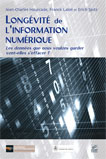Edp Sciences : April 2010, 106 pp.
Life expectancy for digital data supports: what is the risk that data we wish to save may one day be erased?
Why should we pay any attention to long-term preservation of digital data, at a time when digital storage capacities have never been so abundant or so cheap?
This question leads to a point that is becoming more and more relevant: our societies today generate ever-increasing amounts of information, while, at the same time, the expected operational life of the supports available has never been so short, relatively speaking. Short-term data storage or safeguarding processes do not raise any particular questions. In contradistinction, archiving over several decades or even centuries raises a totally different issue, inasmuch as the material used for the digital support usually has a life expectancy of between 5 to 10 years, as an approximation.
Bearing in mind that the technical evolution of support materials and processes is difficult to foresee, only a constant follow-up of error-free data status enables you to guarantee long range archiving albeit with a high associated organisation and implementation cost.
Consequently, a joint Working Party was set up by the <place w:st=”on”><placetype w:st=”on”>Academy</placetype> of <placename w:st=”on”>Sciences</placename></place> and the National Academy of Technologies of France (NATF), with the remit to make a status report on the subject. This report had a well-defined scope: indeed, this is a necessity given the numerous digressions possible. It focused on that part of the information world that conserves a long-term intrinsic value, whether in the form of personal documents, family souvenirs, medical data, etc., or public information (e.g., scientific data acquired from single, so-called “one-shot” experiments, etc.). Various strategies are discussed and a review is made of the different support processes, with a brief discussion of their respective strong and weak points. The fourth part of the report assesses possible generalisation of an active strategy to meet the total requirements of Society. A closer look is made at recordable optical disks (RODs), for which a series of disturbing control measurements have been carried out recently. The authors propose several routes that could lead to far better life expectancy of RODs and make 4 recommendations so that users become aware of the problem in general and also of possible solutions.
Erich SPITZ, Chair of this WP, Fellow of the Academy of Sciences and NATF; Franck LALOE, WP Minute-Writer CNRS / École normale supérieure, and Jean-Charles HOURCADE, Fellow of NATF.
https://www.edp-open.org/images/stories/books/fulldl/Longevite-Info-Num_ebook.pdf

